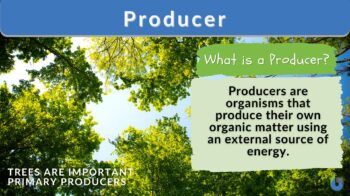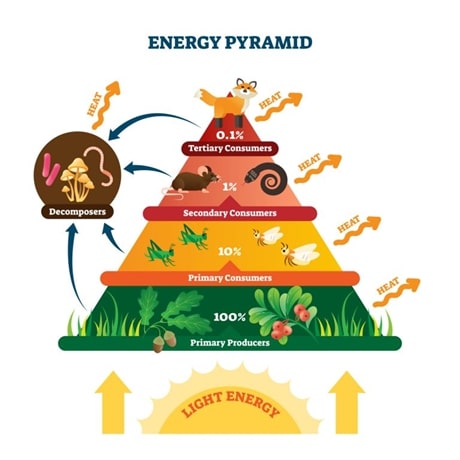
Producer
n., plural: producers
[pɹəˈdʒuːsə]
Definition: An organism capable of producing its own organic food using an external energy source
Table of Contents
Producer Definition
Producers are organisms that can produce organic matter using an external energy source. They include both the photoautotrophs and the chemoautotrophs. Photoautotrophs are organisms that can convert gaseous carbon dioxide into simple carbohydrates like glucose using light energy. Chemoautotrophs, in turn, are organisms that make use of energy from chemical reactions (e.g., by oxidizing inorganic compounds like sulfur, ammonia, and iron) to produce organic compounds from carbon dioxide.
Primary production(or primary productivity) refers to the process of generating organic compounds from inorganic carbon sources. Solar radiation, chemical reactions, or heat from deep sea geothermal vents can all provide energy for this process. Plants are the most prevalent land producer. The primary aquatic producers are algae and plankton.
In general, the word “producer” has various meanings. For instance, it may refer to a film producer, executive producer, and many other kinds that have to do with human career positions related to ‘production’, which could be about the distribution and marketing teams, commercial awareness, the film industry, a production team, a stage director, an entire project and all the creative processes.
However, in biology and ecology, species that make food for themselves and other species are known as producers. Autotrophs (another way to say the word producer or producer noun) are organisms that make their own sustenance. They are sometimes known as autotrophic organisms. One of the main elements of this diet is energy from the sun or chemicals.
Producers turn this energy into sugar or food, which are useable, different types of energy, with the help of water. They produce organic chemicals by combining energy and simple inorganic substances or molecules. Producer stability is critical for ecosystems since all species require organic compounds or materials.
Many producers are mostly green plants that use sunshine and water to produce glucose through the photosynthesis process. While algae are protists, as a type of single-celled organism with a different cellular structure than plants, they can also produce their own food. As a result, it is a “manufacturer”.
Producers are the foundation of every food web in every environment. Primary producers, to be precise, occupy the first trophic level of the food web or the Energy Pyramid.
Organisms that feed on the primary producers are referred to as “secondary producers” or “primary consumers”.and they make up the second trophic level. Herbivores, or animals that eat plants, are examples of such organisms.
Having mentioned the “secondary producers”, it is important to note that they aren’t the producers that are being referred to in the biological or ecological definition of “producer”. The word “producer” is generally used to pertain to organisms that can make their own food, whether by photosynthesis or by chemosynthesis. Secondary producers are heterotrophs. They do not make their own food but consume organic material (from the primary producers or other consumers) to be converted or assimilated into their own biomass. In this regard, they may be viewed as “producers”; they contribute to the ecological production of biomass by converting organic compounds into another form of organic compounds. This form of production or productivity is referred to as secondary productivity. The secondary producers (or primary consumers) are essential, nonetheless. They transfer the energy and nutrients from the primary producers to the higher trophic levels, such as secondary and tertiary consumers, or to the decomposers in a food chain.
Secondary consumers are the carnivores and omnivores that devour the primary consumers. Finally, decomposers decompose dead organisms, returning critical nutrients to the soil and resuming the cycle.
Note it!
Secondary, Tertiary, and Quaternary Producers?
Terms like ‘secondary producers’ and ‘tertiary producers’ are occasionally used. Secondary producers are animals that feed on plants because they ‘generate’ biomass for their predators. Similarly, carnivores that are consumed by other species are referred to as “tertiary producers.” The consumer can only acquire 10% of the calories supplied to the producer at each trophic level. As a result, energy pyramids with more than four tiers, or ‘quaternary producers’ are uncommon.


.
Watch this vid about producers, consumers in food webs and Energy Pyramids:
A producer is an autotrophic organism capable of producing complex organic compounds from simple inorganic molecules through the process of photosynthesis (using light energy) or through chemosynthesis (using chemical energy). Thus, autotrophs are another term for producers, which means “self-nourishers“. Examples of producers are photoautotrophs, which are photosynthesis producers. Trees, grasses, and shrubs are the most important terrestrial photoautotrophs. Algae are the most important photoautotrophs in the majority of aquatic habitats, including lakes and oceans. All life on earth is directly or indirectly reliant on producers, hence, they form the base of the food chain.
Etymology: Latin prōdūcere, to lead or bring forward, extend, prolong, produce + –er
Synonym: autotroph
Types of Producers
The two principal categories of primary producers are:
- Phototrophs
- Chemoautotrophs
Phototrophs (or photoautotrophs) use the sun’s energy to convert carbon dioxide into carbohydrates. The method through which this occurs is known as photosynthesis. Later, the chemical bond energy in carbohydrates is released by respiration and used to fuel metabolic processes.
Chemoautotrophs go through a similar process, however, the energy source is inorganic oxidation and reduction reactions. Chemoautotrophs are almost invariably tiny and live in areas where water and light are scarce.
Examples of Producers
Plants, cyanobacteria, and phytoplankton are the three major types of photosynthetic producers. Thiobacillus — a chemoautotroph and a producer — also has an important role in many ecosystems.
-
Plants
Plants are astonishingly diverse, ranging from microscopic species to redwoods that tower over the globe. Surprisingly, these diverse species all use the same photosynthetic mechanism. Photosynthesis takes place in specialized organelles called chloroplasts, which contain pigments like chlorophyll.
These pigments are typically found in light-harvesting complexes, scaffolds of membrane-bound proteins. Light-driven oxidation causes the pigment to lose an electron in this case. The high-energy electron then joins an electron transport chain, where it goes from one protein to the next, losing energy at each step, while also participating in a sequence of oxidation and reduction reactions.
The passage of a charged particle via the electron transport chain also contributes to the formation of a proton gradient across the membrane. The proton gradient and the electron transport chain work together to create adenosine triphosphate (ATP), the cell’s energy currency.
The photo-oxidized chlorophyll pigment is subsequently restored to its native condition by breaking a water molecule, which releases molecular oxygen.
Producer Gas is a gas mixture containing carbon monoxide, carbon dioxide, nitrogen, and hydrogen. Carbon monoxide gas and hydrogen gas are combustible gases derived from these gases. Carbon dioxide and nitrogen gases are not combustible.
-
Cyanobacteria and other photoautotrophic bacteria
Cyanobacteria are examples of prokaryotes that can photosynthesize. They are among the first life forms to arise on Earth, with a fossil record dating back over three billion years. They also helped to create an oxygen-rich atmosphere over two billion years, opening the stage for the kinds of life forms we see today. They were first categorized as algae due to their photosynthetic activity, and the name ‘blue-green algae‘ is still used informally to refer to these prokaryotes.
Cyanobacteria are thought to be the endosymbionts that evolved into chloroplasts. Membrane protein complexes, which are part of the cell, are also found in the cell membranes of these prokaryotes. Some of these membranes produce cylindrical thylakoid sheets that look like chloroplasts’ internal structures. These commonalities make them helpful as model animals for studying photosynthesis.
However, there are some differences between the paths or pathways used by modern cyanobacteria and plants. One of these stems from the marine nature of these prokaryotes, which necessitates them to ‘concentrate’ carbon dioxide in small vesicle-bound compartments to boost the efficacy of photosynthetic enzymes like RuBisCO.
They are critical for the health and survival of marine ecosystems because they play a major role in the bioavailable carbon and nitrogen production process. Nitrogen is fixed as ammonia and used to make nitrogen-containing molecules like proteins and nucleic acids. Cyanobacteria are among the most significant marine primary and food producers because they are devoured by species in the ocean bed, shallow waters, and open seas.
Other photoautotrophic bacteria that can be regarded as producers are green sulfur bacteria (Chlorobi bacteria) and green non-sulfur bacteria (Chloroflexi bacteria). These are obligate phototrophs using bacteriochlorophylls for photosynthesis.
-
Phytoplankton
More examples of producers are phytoplankton. Phytoplankton are microscopic free-floating plants that perform the majority of the ocean’s photosynthetic activity. They are the foundation of aquatic ecosystems and help to keep the ocean and atmosphere oxygenated.
They are eaten by minute herbivorous animals called zooplankton, which are then eaten by other organisms higher up the food pyramid. The advent of phytoplankton is thought to have contributed to a huge evolutionary boom 250 million years ago.
Following a mass extinction at the end of the Paleozoic era, an increase in nutrients and a decrease in predation allowed these plants to proliferate in the oceans. Their abundance – that is, how much of it – and increased nutritional content – how much provides for the organism – also allowed primary consumers, such as zooplankton, to proliferate.
As these organisms evolved and colonized greater ocean tracts, some populations diversified and adapted to new conditions, resulting in an unprecedented increase in species variety in the seas.
-
Thiobacillus
Thiobacillus sp. is a genus of gram-negative bacteria. The members of this group are capable of chemosynthesis, utilizing carbon dioxide (an inorganic compound) as its sole source of carbon and producing organic compounds (e.g., glucose) driven by chemical energy they derive by oxidizing inorganic compounds like sulfur or iron. As a producer, they are an important food source for various organisms, such as other bacteria, fungi, protists, and even grazers like snails, limpets, and crabs that feed on biofilms containing Thiobacillus.
Note it!
Producers are exemplified by photoautotrophs and chemoautotrophs that use carbon dioxide as a carbon source and use energy from an external source (e.g., energy from photosynthesis and energy from the oxidation of inorganic compounds) to produce an organic compound, which may be utilized by consumers and decomposers for conversion into their own biomass.
Functions of Producers
Producers are the primary source of biomass on the planet. They are like the person responsible for the preservation of life in the ecosystem. They are the bottom of all energy pyramids and the first trophic level in every ecosystem. Primary producers use energy from the sun or chemical reactions to fix inorganic carbon in the form of carbs.
Because of their involvement in carbon dioxide sequestration, they are critical for global weather patterns, ensuring ideal temperature and annual rainfall. As a consequence of photosynthesis, oxygen is produced, and consumed by all organisms to release the chemical energy trapped in carbohydrates.
Other producers, such as lichens, are crucial as pioneer species, changing the abiotic environment to make it more habitable. They hasten weathering and increase organic matter deposition, resulting in soil formation.
Producers and abiotic variables play an important role in defining species diversity in a region. When plankton are the dominant producers, for example, filter-feeding herbivores will proliferate, followed by carnivores that can ingest these species.
Regions with towering trees, on the other hand, will encourage herbivores like giraffes that can reach the highest branches, and will then prefer predators who can hunt these fast creatures. As a result, the primary producer serves as the foundation of the entire ecosystem.
Note it!
Producers are usually grouped with Consumers and Decomposers as the three main positions of the food chain that an organism can hold.
Take the Producers – Biology Quiz!
Further Reading
References
- Foundation, C.-12. (n.d.). Producers, Consumers, and Decomposers | CK-12 Foundation. Retrieved May 2, 2023, from https://flexbooks.ck12.org/cbook/cbse-biology-class-10/section/4.3/primary/lesson/producers-consumers-and-decomposers/
- Producer | biology | Britannica. (n.d.). Retrieved May 2, 2023, from https://www.britannica.com/science/producer-biology
- Producer gas. (n.d.). Retrieved May 2, 2023, from https://byjus.com/question-answer/producer-gas-contains-mainly-nitrogen-and-carbon-monoxidehydrogen-and-nitrogennitrogen-and-carbon-dioxidehydrogen-and-carbon/
- Producers. (n.d.). Retrieved May 2, 2023, from https://education.nationalgeographic.org/resource/producers
- Producers & Consumers Overview & Examples | What Is a Producer? – Video & Lesson Transcript. (n.d.). Study.Com. Retrieved May 2, 2023, from https://study.com/learn/lesson/producers-consumers-overview-examples.html
- Producers—Definition, Types, Examples. (2022, October 4). https://microbiologynote.com/producers/
©BiologyOnline.com. Content provided and moderated by Biology Online Editors.

